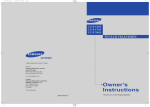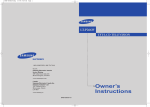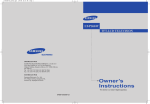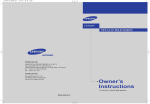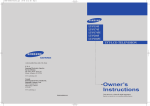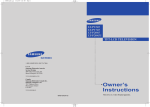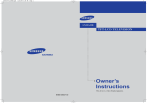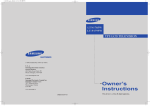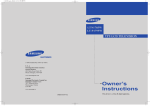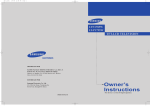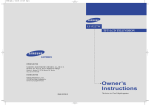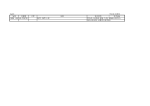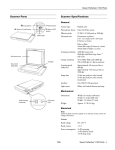Download Samsung LN-R1742 User's Manual
Transcript
BN68-00870A-00cover.qxd 1/15/04 1:22 AM Page 1 LN-R1742 1-800-SAMSUNG(1-800-726-7864) U.S.A Samsung Electronics America Service Division 400 Valley Road, Suite 201 Mount Arlington, NJ 07856 www.samsung.com Canada Samsung Electronics Canada Inc. Samsung Customer Care 7037 Financial Drive Mississauga, Ontario L5N 6R3 www.samsung.ca BN68-00870A-00 This device is a Class B digital apparatus. Register your product at www.samsung.com/global/register Eng.qxd 1/15/04 1:18 AM Page 1 Precautions When Displaying a Still Image A still image may cause permanent damage to the TV screen. • Digital Ready TV: When you select the regular screen (4:3) mode to watch an SD-grade digital broadcast (and the set-top box output is 480p). • Digital Ready TV: When you Although digital broadcasting must be in the wide screen (16:9) HD format, broadcasters sometimes show programs made originally in the regular screen format (4:3) by converting the signals into digital form, in which case the left and right side edges of the screen are cropped. Note : If the borders at the left, right and the center of the screen remain fixed for an extended period of time, the amount of light transmission will also remain varied and as a result the borders may leave traces. select the wide screen (16:9) mode to watch an SD-grade digital broadcast (and the set-top box output is 1080i). Do not leave the screen in pause mode for extended periods of time as you may experience temporary or permanent image burn. • Digital Ready TV: When the TV receives HD-grade signals (and the set-top box output is 1080i). When you watch a digital HD-grade broadcast on a regular (4:3) TV with the screen size "16:9" or "Panorama" selected, you will be able to watch the program but the top and bottom edges of the screen will be cropped. Note : If the borders at the top, bottom and the center of the screen remain fixed for an extended period of time, the amount of light transmission will also remain varied and as a result the borders may leave traces. Do not leave the screen in pause mode for extended periods of time as you may experience temporary or permanent image burn. Eng.qxd 1/15/04 1:18 AM Page 2 • Integrated Digital TV (Wide-screen): When the TV receives SD-grade (regular) broadcasting signals (receives 480p regular signals). • Digital Ready TV (wide-screen): digital TV: When the TV receives SD-grade (regular) broadcasting signals (with a set-top box). • When you watch an analog (regular) broadcast on a wide-screen TV (with the 4:3 screen mode selected). Although digital broadcasting must be in the wide screen (16:9) HD format, broadcasters sometimes show programs made originally in the regular screen format (4:3) by converting the signals into digital form, in which case the left and right side edges of the screen are cropped. Note : If the borders at the left, right and the center of the screen remain fixed for an extended period of time, the amount of light transmission will also remain varied and as a result the borders may leave traces. Do not leave the screen in pause mode for extended periods of time as you may experience temporary or permanent image burn. • When you watch a DVD, CD or a video in wide screen (21:9) format on a wide-screen (16:9) TV. • When you connect a computer or a game console to the TV and select the 4:3 screen mode. If you connect a DVD player, computer or a game console to the wide-screen TV and watch a movie or play a game in regular (4:3) or wide (21:9) screen mode, the left and right side edges, or the top and bottom edges of the screen will be cropped. Note : If the borders at the left, right and the center of the screen remain fixed for an extended period of time, the amount of light transmission will also remain varied and as a result the borders may leave traces. Do not leave the screen in pause mode for extended periods of time as you may experience temporary or permanent image burn. BN68-00870A-00Contents.qxd 1/15/04 1:17 AM Page 1 CONTENTS Chapter 1: Your New TV List of Features . . . . . . . . . . . . . . . . . . . . . . . . . . . . . . . . . . . . . . . . . . . .1 List of Parts . . . . . . . . . . . . . . . . . . . . . . . . . . . . . . . . . . . . . . . . . . . . . . 1 Familiarizing Yourself with Your New TV . . . . . . . . . . . . . . . . . . . . . . .2 Front Panel Buttons . . . . . . . . . . . . . . . . . . . . . . . . . . . . . . . . .2 Rear Panel Jacks . . . . . . . . . . . . . . . . . . . . . . . . . . . . . . . . . . . .3 Remote Control . . . . . . . . . . . . . . . . . . . . . . . . . . . . . . . . . . . . .4 Installing Batteries in the Remote Control . . . . . . . . . . . . . . . .5 If remote control doesn’t work! . . . . . . . . . . . . . . . . . . . . . . . .5 Chapter 2: Installation Connecting VHF and UHF Antennas . . . . . . . . . . . . . . . . . . . . . . . . . . .6 Antennas with 300-ohm Flat Twin Leads . . . . . . . . . . . . . . . . .6 Antennas with 75-ohm Round Leads . . . . . . . . . . . . . . . . . . . .7 Separate VHF and UHF Antennas . . . . . . . . . . . . . . . . . . . . . .7 Connecting Cable TV . . . . . . . . . . . . . . . . . . . . . . . . . . . . . . . . . . . . . . .7 Cable without a Cable Box . . . . . . . . . . . . . . . . . . . . . . . . . . . .7 Connecting to a Cable Box that Descrambles All Channels . . .8 Connecting to a Cable Box that Descrambles Some Channels . .8 Connecting a VCR . . . . . . . . . . . . . . . . . . . . . . . . . . . . . . . . . . . . . . . . .10 Connecting an S-VHS VCR . . . . . . . . . . . . . . . . . . . . . . . . . . . . . . . . .11 Connecting a DVD Player . . . . . . . . . . . . . . . . . . . . . . . . . . . . . . . . . . .12 Chapter 3: Special Features Turning the TV On and Off . . . . . . . . . . . . . . . . . . . . . . . . . . . . . . . . . .13 Changing Channels . . . . . . . . . . . . . . . . . . . . . . . . . . . . . . . . . . . . . . . .13 Using the Channel Buttons . . . . . . . . . . . . . . . . . . . . . . . . . . .13 Using the PRE-CH Button to select the Previous Channel . .13 Adjusting the Volume . . . . . . . . . . . . . . . . . . . . . . . . . . . . . . . . . . . . . .13 Using Mute . . . . . . . . . . . . . . . . . . . . . . . . . . . . . . . . . . . . . . .13 Viewing the Display . . . . . . . . . . . . . . . . . . . . . . . . . . . . . . . . . . . . . . .14 Viewing the Menus . . . . . . . . . . . . . . . . . . . . . . . . . . . . . . . . . . . . . . . .14 Chapter 4: Operation Plug & Play Feature . . . . . . . . . . . . . . . . . . . . . . . . . . . . . . . . . . . . . . . .15 Memorizing the Channels . . . . . . . . . . . . . . . . . . . . . . . . . . . . . . . . . . .16 Selecting the Video Signal-source . . . . . . . . . . . . . . . . . . . . .16 Storing Channels in Memory (Automatic Method) . . . . . . . .17 To check the channels stored in memory . . . . . . . . . . . . . . . .17 To select channels over 100 . . . . . . . . . . . . . . . . . . . . . . . . . .17 ADD and DEL Channels (Manual Method) . . . . . . . . . . . . . .18 To select the Input Source . . . . . . . . . . . . . . . . . . . . . . . . . . . . . . . . . .19 To Edit the Input Source Name . . . . . . . . . . . . . . . . . . . . . . . . . . . . . . .20 Using Automatic Picture Settings . . . . . . . . . . . . . . . . . . . . . . . . . . . . .21 Customizing the Picture . . . . . . . . . . . . . . . . . . . . . . . . . . . . . . . . . . . .22 Using Automatic Sound Settings . . . . . . . . . . . . . . . . . . . . . . . . . . . . . .23 To select the Sound option . . . . . . . . . . . . . . . . . . . . . . . . . . . . . . . . . .24 CONTENTS 1 BN68-00870A-00Contents.qxd 1/15/04 1:17 AM Page 2 CONTENTS Selecting a Menu Language . . . . . . . . . . . . . . . . . . . . . . . . . . . . . . . . .25 Setting the Blue Screen Mode . . . . . . . . . . . . . . . . . . . . . . . . . . . . . . . .26 Adjusting the Color Tone . . . . . . . . . . . . . . . . . . . . . . . . . . . . . . . . . . .27 Automatic Volume Control . . . . . . . . . . . . . . . . . . . . . . . . . . . . . . . . . .28 Setting the Clock . . . . . . . . . . . . . . . . . . . . . . . . . . . . . . . . . . . . . . . . .29 Option 1: Setting the Clock Manually . . . . . . . . . . . . . . . . . .29 Option 2: Using the Local PBS Channel to Automatically Set the TV Clock . . . . . . . . . . . . . . . . . . . . . . . . . .30 Setting the On/Off Timer . . . . . . . . . . . . . . . . . . . . . . . . . . . . . . . . . . .32 Setting the Sleep Timer . . . . . . . . . . . . . . . . . . . . . . . . . . . . . . . . . . . .34 Sleep timer . . . . . . . . . . . . . . . . . . . . . . . . . . . . . . . . . . . . . . .34 Viewing Closed Captions . . . . . . . . . . . . . . . . . . . . . . . . . . . . . . . . . . .35 Using the V-Chip . . . . . . . . . . . . . . . . . . . . . . . . . . . . . . . . . . . . . . . . . .36 Setting Up Your Personal ID Number (PIN) . . . . . . . . . . . . .36 How to Enable/Disable the V-Chip . . . . . . . . . . . . . . . . . . . . .37 How to Set up Restrictions Using the ‘TV guidelines’ . . . . .38 How to Set up Restrictions Using the MPAA Ratings: G, PG, PG-13, R, NC-17, X . . . . . . . . . . . . . . . . . . . . . . . . . .40 How to Reset the TV after the V-Chip Blocks a Channel (‘Emergency Escape’) . . . . . . . . . . . . . . . .41 How to Set up Restrictions Using the Canadian English . . . .42 How to Set up Restrictions Using the Canadian French . . . . .43 Chapter 5: PC Display Using Your TV as a Computer (PC) Display . . . . . . . . . . . . . . . . . . . . .44 How to Set up Your PC Software (Windows only) . . . . . . . .44 Adjusting the Screen Quality . . . . . . . . . . . . . . . . . . . . . . . . .45 Changing the Screen Position . . . . . . . . . . . . . . . . . . . . . . . . .46 To Initialize the Screen Position or Color Settings . . . . . . . . .47 How to Auto Adjust . . . . . . . . . . . . . . . . . . . . . . . . . . . . . . . .48 Using Automatic Picture Settings . . . . . . . . . . . . . . . . . . . . . . . . . . . . .49 Customizing the Picture . . . . . . . . . . . . . . . . . . . . . . . . . . . . . . . . . . . .50 Adjusting the Color Tone . . . . . . . . . . . . . . . . . . . . . . . . . . . . . . . . . . .51 Customizing the Color . . . . . . . . . . . . . . . . . . . . . . . . . . . . . . . . . . . . . .52 Chapter 6: Troubleshooting Identifying Problems . . . . . . . . . . . . . . . . . . . . . . . . . . . . . . . . . . . . . . .53 Appendix Using the Anti-Theft Kensington Lock . . . . . . . . . . . . . . . . . . . . . . . . .55 Retractable Stand . . . . . . . . . . . . . . . . . . . . . . . . . . . . . . . . . . . . . . . . . .56 Installing VESA compliant mounting devices . . . . . . . . . . . . . . . . . . . .57 Installing the Wall Mount Kit . . . . . . . . . . . . . . . . . . . . . . . . . . . . . . . .58 Display Mode . . . . . . . . . . . . . . . . . . . . . . . . . . . . . . . . . . . . . . . . . . . .61 Using Your TV in Another Country . . . . . . . . . . . . . . . . . . . . . . . . . . . .61 Specifications . . . . . . . . . . . . . . . . . . . . . . . . . . . . . . . . . . . . . . . . . . . .62 CONTENTS 2 BN68-00870A-00Eng 1.qxd 1/15/04 12:48 AM Page 1 Chapter One Y O U R N E W TV List of Features Your TV was designed with the latest technology. This TV is a high-performance unit that includes the following special features: • Easy-to-use remote control • Easy-to-use on-screen menu system • Automatic timer to turn the TV on and off • Adjustable picture and sound settings that can be stored in the TV’s memory • Automatic channel tuning for up to 194 channels.(Air : 69 , STD : 125 ) • A special filter to reduce or eliminate reception problems • Fine tuning control for the sharpest picture possible • A built-in multi-channel sound decoder for stereo and bilingual listening • Built-in, dual channel speakers • Headphone jack for private listening List of Parts Please make sure the following items are included with your LCD TV. If any items are missing, contact your dealer. 17” Remote Control (BN59-00429A) & Batteries (AAA x 2) 17” Power Cord Wall Mount kit 17" : 3903-000144 17" : BN96-01270A English-1 Owner’s Instructions BN68-00870A-00Eng 1.qxd 1/15/04 12:48 AM Page 2 Y O U R N E W TV Familiarizing Yourself with Your New TV Front Panel Buttons The buttons on the front panel control your TV’s basic features, including the on-screen menu. To use the more advanced features, you must use the remote control. SOURCE Displays a menu of all of the available input sources (TV, VIDEO, S-VIDEO, Component, PC) You can also use the SOURCE( button on the TV’s control panel to make selections. ) POWER Press to turn the TV on and off. HEADPHONE JACK Connect a set of external headphones to this jack for private listening. SPEAKERS MENU Press to see an on-screen menu of your TV’s features. – VOL + Press to decrease or increase the volume. Press to see an on-screen menu on the screen. CH Press to change channels. Also press to highlight various items on the on-screen menu. English-2 REMOTE CONTROL SENSOR Aim the remote control towards this spot on the TV. POWER INDICATOR Lights up when you turn the power off. (Red light shows in stand-by mode, Red shows when you turn the power on, and light is off after the power is on. Green shows when you set Timer on or off.) BN68-00870A-00Eng 1.qxd 1/15/04 12:48 AM Page 3 Y O U R N E W TV Rear Panel Jacks Use the rear panel jacks to connect an A/V component that will be connected continuously, such as a VCR or a DVD player. For more information on connecting equipment, see pages 6~12. < LN-R1742 > POWER INPUT S-VIDEO INPUT PC AUDIO IN (STEREO) Connect an S-Video signal from a camcorder or VCR. PC VIDEO INPUT TV ANTENNA Connect to the video output port on your PC. Connect to an antenna or to a cable TV system. VIDEO INPUT Connect a video signal from a camcorder or VCR. COMPONENT Connect a component video/audio. AUDIO INPUT Connect an audio signal(L/R) from a camcorder or VCR. English-3 KENSINGTON LOCK (See page 55) BN68-00870A-00Eng 1.qxd 1/15/04 12:48 AM Page 4 Y O U R N E W TV Remote Control You can use the remote control up to a distance of about 23 feet from the TV. When using the remote, always point it directly at the TV. POWER (See Page 13) PRE-CH Turns the TV on and off. Turns to the previous channel. NUMBER BUTTONS SOURCE(See Page 19) Press to select channels directly on the TV. Input source selection +100 INFO DISPLAY Press to select channels over 100. For example, to select channel 121, press “+100,” then press “2” and “1.” Use to see information on the current broadcast. EXIT Press the menu to exit. CH and CH (Channel Up/Down) Press CH or CH change channels. ADD/DEL to Use to store and delete channels to/from memory. VOL+ and VOLPress to increase or decrease the volume. CAPTION Press to set caption on/off. MUTE (See Page 13) Press to temporarily cut off the sound. MTS (Multichannel Television Stereo) SLEEP(See Page 34) Press to choose stereo, mono or Separate Audio Program (SAP broadcast). Press to select a time for the TV to turn off automatically. S.MODE MENU Adjust the TV sound by selecting one of the preset factory settings. Displays the main on-screen menu. UP/DOWN/LEFT/ RIGHT/ENTER Use to select on-screen menu items and change menu values. (The remote control will only function with VCR or DVD units that are compatible with the LCD TV.) AUTO PROG. Use to store the broadcast/cable channels that you receive. P.MODE Adjust the TV picture by selecting one of the preset factory settings. English-4 BN68-00870A-00Eng 1.qxd 1/15/04 12:48 AM Page 5 Y O U R N E W TV Installing Batteries in the Remote Control 1 Slide the cover out completely. Make sure to match the “+” and 2 “–” ends of the batteries with the diagram inside the compartment. Install two AAA size batteries. Remove the batteries and store them in a cool, dry place if you won’t be using the remote control for a long time. 3 Replace the cover. The remote control can be used up to about 23 feet from the TV. (Assuming typical TV usage, the batteries last for about one year.) If remote control doesn’t work Check the following: 1. Is the TV power switch on? 2. Are the plus and minus ends of the batteries reversed? 3. Did the batteries run out? 4. Is the power out, or is the power cord unplugged? 5. Is there a special fluorescent light or a neon sign nearby? English-5 BN68-00870A-00Eng 1.qxd 1/15/04 12:48 AM Page 6 C h a p t e r Tw o I N S TA L L AT I O N Connecting VHF and UHF Antennas If your antenna has a set of leads that look like this, see “Antennas with 300-ohm Flat Twin Leads” below. If your antenna has one lead that looks like this, see “Antennas with 75-ohm Round Leads” on page 7. If you have two antennas, see “Separate VHF and UHF Antennas” on page 7. Antennas with 300-ohm Flat Twin Leads If you are using an off-air antenna (such as a roof antenna or “rabbit ears”) that has 300-ohm twin flat leads, follow the directions below. 1 Place the wires from the twin leads under the screws on a 30075 ohm adaptor (not supplied). Use a screwdriver to tighten the screws. 2 Plug the adaptor into the TV ANTENNA terminal on the bottom of the back panel. English-6 BN68-00870A-00Eng 1.qxd 1/15/04 12:48 AM Page 7 I N S TA L L AT I O N Antennas with 75-ohm Round Leads 1 Plug the antenna lead into the TV ANTENNA terminal on the bottom of the back panel. Separate VHF and UHF Antennas If you have two separate antennas for your TV (one VHF and one UHF), you must combine the two antenna signals before connecting the antennas to the TV. This procedure requires an optional combiner-adaptor (available at most electronics shops). 1 Connect both antenna leads to the combiner. 2 Plug the combiner into the TV ANTENNA terminal on the bottom of the rear panel. Connecting Cable TV To connect to a cable TV system, follow the instructions below. Cable without a Cable Box Because this TV is cable-ready, you do not need a cable box to view unscrambled cable channels. 1 Plug the incoming cable into the TV ANTENNA terminal on the back of the TV. English-7 BN68-00870A-00Eng 1.qxd 1/15/04 12:48 AM Page 8 I N S TA L L AT I O N Connecting to a Cable Box that Descrambles All Channels This terminal might be labeled “ANT OUT”, “VHF OUT”, or simply, “OUT”. 1 Find the cable that is connected to the ANTENNA OUT terminal on your cable box. 2 Connect the other end of this cable to the TV ANTENNA terminal on the back of the TV. Connecting to a Cable Box that Descrambles Some Channels If your cable box descrambles only some channels (such as premium channels), follow the instructions below. You will need a two-way splitter, an RF (A/B) switch, and four lengths of coaxial cable. (These items are available at most electronics stores.) This terminal might be labeled “ANT IN”, “VHF IN”, or simply, “IN”. 1 Find and disconnect the cable that is connected to the ANTENNA IN terminal on your cable box. 2 Connect this cable to a two-way splitter. 3 Connect a coaxial cable between an OUTPUT terminal on the splitter and the IN terminal on the cable box. English-8 BN68-00870A-00Eng 1.qxd 1/15/04 12:48 AM Page 9 I N S TA L L AT I O N 4 Connect a coaxial cable between the ANTENNA OUT terminal on the cable box and the B–IN terminal on the A/B switch. 5 Connect another cable between the other OUT terminal on the splitter and the A–IN terminal on the RF (A/B) switch. 6 Connect the last coaxial cable between the OUT terminal on the RF (A/B) switch and the VHF/UHF terminal on the rear of the TV. After you’ve made this connection, set the A/B switch to the “A” position for normal viewing. Set the A/B switch to the “B” position to view scrambled channels. (When you set the A/B switch to “B,” you will need to tune your TV to the cable box’s output channel, which is usually channel 3 or 4.) English-9 BN68-00870A-00Eng 1.qxd 1/15/04 12:48 AM Page 10 I N S TA L L AT I O N Connecting a VCR These instructions assume that you have already connected your TV to an antenna or a cable TV system (according to the instructions on pages 6-9). Skip step 1 if you have not yet connected to an antenna or a cable system. 1 Unplug the cable or antenna from the back of the TV. 2 Connect the cable or antenna to the ANTENNA IN terminal on the back of the VCR. 3 Connect a coaxial cable between the ANTENNA OUT terminal on the VCR and the antenna terminal on the TV. A coaxial cable is usually included with a VCR. (If not, check your local electronics store). 4 Connect a set of audio cables between the AUDIO OUT jacks on the VCR and the AUDIO jacks on the TV. If you have a “mono” (non-stereo) VCR, use the Y-connector (not supplied) to hook up to the left and right audio input jacks of the TV. If your VCR is stereo, you must connect two cables. 5 Connect a video cable between the VIDEO OUT jack on the VCR and the VIDEO jack on the TV. Follow the instructions in “Viewing a VCR or Camcorder Tape” to view your VCR tape. * Each external input source device has a different back panel configuration. English-10 BN68-00870A-00Eng 1.qxd 1/15/04 12:48 AM Page 11 I N S TA L L AT I O N Connecting an S-VHS VCR Your Samsung TV can be connected to an S-Video signal from an S-VHS VCR. (This connection delivers a better picture as compared to a standard VHS VCR.) 1 To begin, follow steps 1–3 in the previous section to connect the antenna or cable to your VCR and your TV. 2 Connect a set of audio cables between the AUDIO OUT jacks on the VCR and the AUDIO INPUT jacks on the TV. 3 Connect an S-video cable between the S-VIDEO OUT jack on the VCR and the S-VIDEO INPUT jack on the TV. An S-video cable is usually included with an S-VHS VCR. (If not, check your local electronics store.) * Each external input source device has a different back panel configuration. English-11 BN68-00870A-00Eng 1.qxd 1/15/04 12:48 AM Page 12 I N S TA L L AT I O N Connecting a DVD Player The rear panel jacks on your TV make it easy to connect a DVD player to your TV. 1 Connect a set of audio cables between the L, R AUDIO INPUT jacks on the TV and the AUDIO OUT jacks on the DVD player. 2 Connect a video cable between the COMPONENT (Y, Pb, Pr) jacks on the TV and the Y, Pb, Pr jacks on the DVD player. Note : For an explanation of Component video, see your DVD player owner's manual. The component terminal of this set only supports 480i/480p resolution. * Each external input source device has a different back panel configuration. English-12 BN68-00870A-00Eng 1.qxd 1/15/04 12:48 AM Page 13 Chapter Three S P E C I A L F E AT U R E S Turning the TV On and Off Press the POWER button on the remote control. You can also use the Power button on the front panel. Changing Channels Using the Channel Buttons 1 Press the CH / buttons to change channels. When you press the CH / buttons, the TV changes channels in sequence. You will see all the channels that the TV has memorized. (The TV must have memorized at least three channels.) You will not see channels that were either erased or not memorized. Using the PRE-CH Button to select the Previous Channel 1 Press the PRE-CH button. The TV will switch to the last channel viewed. To quickly switch between two channels that are far apart, tune to one channel, then use the number button to select the second channel. Then use the PRE-CH button to quickly alternate between them. Adjusting the Volume 1 To control speaker volume. 2 To control headphone volume. - when headphone is connected. When a headphone is connected, the Volume Control OSD screen changes automatically as in number 2. Press the VOL +/– buttons to increase or decrease the volume. Using Mute At any time, you can temporarily cut off the sound using the Mute button. 1 Press MUTE and the sound cuts off. The word “ ” will appear in the lower-left corner of the screen. 2 To turn mute off, press the MUTE button again, or simply press the VOL +/- buttons. English-13 BN68-00870A-00Eng 1.qxd 1/15/04 12:48 AM Page 14 S P E C I A L F E AT U R E S Viewing the Display The display identifies the current channel and the status of certain audio-video settings. The on-screen displays disappear after about ten seconds. Press the button once more or wait approximately 10 seconds and it disappears automatically. Allows the user to adjust the settings according to his/her preference and shows the current settings. 1 Press the INFO button on the remote control. The TV will display the channel, the type of sound, and the status of certain picture and sound settings. Viewing the Menus The on-screen menus disappear from the screen after about two minutes. 1 With the power on, press the MENU button. The main menu appears on the screen. Its left side has five icons: Input, Picture, Sound, Channel, and Setup. 2 Use the UP/DOWN buttons to select one of the five icons. Then press ENTER to access the icon’s sub-menu. 3 Press the EXIT button to exit. English-14 You can also use the SOURCE buttons on the control panel of the TV to make selections.(See page 19) BN68-00870A-00Eng 2.qxd 1/15/04 12:49 AM Page 15 Chapter Four O P E R AT I O N Plug & Play Feature When the TV is initially powered On, two basic customer settings proceed automatically and subsequently: Setting Auto program, Clock. 1 Press the POWER button on the remote control. The message “Plug & Play” is displayed. 2 Press the UP/DOWN buttons to select “English”, “Français”, “Español”, or “Português” then press the ENTER button. Press the UP/DOWN buttons to select “Air”,“STD”, “HRC” or “IRC”, then press the ENTER button. 3 Press the ENTER Button. The TV will begin memorizing all of the available channels. Press the ENTER button to stop. 4 Press the LEFT/RIGHT buttons to move to the “Hour”, “Minute” or “am/pm”. Set the “Hour”, “Minute” or “am/pm” by pressing the UP/DOWN buttons. Press the MENU button. (refer to “Setting the Clock” on page 29). 5 The message “Enjoy your watching.” is displayed. English-15 BN68-00870A-00Eng 2.qxd 1/15/04 12:49 AM Page 16 O P E R AT I O N Memorizing the Channels Your TV can memorize and store all of the available channels for both “off-air” (antenna) and cable channels. After the available channels are memorized, use the CH and CH buttons to scan through the channels. This eliminates the need to change channels by entering the channel digits. There are three steps for memorizing channels: selecting a broadcast source, memorizing the channels (automatic) and adding and deleting channels (manual). Selecting the Video Signal-source Before your television can begin memorizing the available channels, you must specify the type of signal source that is connected to the TV (i.e., an antenna or a cable system). 1 Press the MENU button to display the menu. Press the UP/DOWN buttons to select “Channel”, then press the ENTER button. 2 Press the ENTER button to cycle through these choices: Air, STD, HRC, or IRC (all cable TV). Press the UP/DOWN buttons to select the Video signal source, then press the ENTER button. Press the EXIT button to exit. Note : STD, HRC and IRC identify various types of cable TV systems. Contact your local cable company to identify the type of cable system that exists in your particular area. At this point, the signal source has been selected. Proceed to “Storing Channels in Memory” (next page). English-16 BN68-00870A-00Eng 2.qxd 1/15/04 12:49 AM Page 17 O P E R AT I O N Storing Channels in Memory (Automatic Method) 1 First, select the correct signal source (Air, STD, HRC, IRC). See steps 1~2 on previous page. Press the MENU button. Press the UP/DOWN buttons to select “Channel”, then press the ENTER button. 2 Press the UP/DOWN buttons to select “Auto Program”. Press the ENTER button. The TV automatically cycles through all of the available channels and stores them in memory. This takes about one to two minutes. 3 Press the ENTER button. The TV will begin memorizing all of the available channels. Press ENTER at any time to interrupt the memorization process and return to the CHANNEL menu. 4 After all the available channels are stored, the Auto Program menu reappears. Press the EXIT button to exit. Note: You can also press the AUTO PROG. button to select available channels. To check the channels stored in memory Press the CH / buttons. Only the channels stored in memory are selected. To select channels over 100 Ex) Press to select channel 108. English-17 BN68-00870A-00Eng 2.qxd 1/15/04 12:49 AM Page 18 O P E R AT I O N ADD and DEL Channels (Manual Method) 1 Use the number buttons to directly select the channel to Add or Delete. Press the MENU button to display the menu. Press the UP/DOWN buttons to select “Channel”, then press the ENTER button. Press the UP/DOWN buttons to select “Add/Delete”. Press the ENTER button. Press the ENTER button to select “Add" or "Delete”. Press the CH / buttons to select channel that you wish to add or delete. If the channel that you wish to edit is not in memory, the “Add” is selected and displayed. Otherwise, if the channel that you wish to edit is in memory, the “Delete” is selected and displayed. Press the EXIT button. 2 (Alternate method) Press the ADD/DEL button. Repeatedly pressing ENTER Press the EXIT button. will alternate between “Add” and “Delete”. You can view any channel (including an erased channel) by using the number buttons on the remote control. English-18 BN68-00870A-00Eng 2.qxd 1/15/04 12:49 AM Page 19 O P E R AT I O N To select the Input Source Use to select TV or other external input sources connected to the TV. Use to select the screen of your choice. 1 Press the MENU button to display the on-screen menu. Press the ENTER button. 2 Press the ENTER button to select “TV”, then press the ENTER button. 3 Press the UP/DOWN buttons to select the Input source, then press ENTER button. Note: You can also press the SOURCE button on the remote to choose the Input source. English-19 BN68-00870A-00Eng 2.qxd 1/15/04 12:49 AM Page 20 O P E R AT I O N To Edit the Input Source Name Name the input device connected to the input jacks to make your input source selection easier. 1 Press the MENU button to display the menu. Press the ENTER button. Press the UP/DOWN buttons to select “Edit Name” then press the ENTER button. 2 Press the UP/DOWN buttons to select “AV”, “S-Video”, “Component”, or “PC” then press the ENTER button. 3 Press the UP/DOWN buttons repeatedly until the appropriate source name appears. After the source is selected, press the ENTER button. Press the EXIT button to exit. Note: DHR = DVD HDD Receiver English-20 BN68-00870A-00Eng 2.qxd 1/15/04 12:49 AM Page 21 O P E R AT I O N Using Automatic Picture Settings Your TV has four automatic picture settings (“Dynamic”, “Standard”, “Movie”, and “Custom”) that are preset at the factory. You can activate either Dynamic, Standard, or Movie by pressing P.MODE (or by making a selection from the menu). Or, you can select “Custom” which automatically recalls your personalized picture settings. 1 Press the MENU button to display the menu. Press the UP/DOWN buttons to select “Picture”, then press the ENTER button. 2 Press the UP/DOWN buttons to select the “Dynamic”, “Standard”, “Movie”, or “Custom” picture setting. Press the ENTER button. Press the EXIT button to exit. Alternate method: Simply press the P.MODE button on the remote control to select one of the standard picture settings. • • • • Choose Dynamic to increase the clarity and sharpness of the picture. Choose Standard for the standard factory settings. Choose Movie when viewing a Movie. Choose Custom if you want to adjust the settings according to personal preference (see “Customizing the Picture”, page 22). English-21 BN68-00870A-00Eng 2.qxd 1/15/04 12:49 AM Page 22 O P E R AT I O N Customizing the Picture You can use the on-screen menus to change the contrast, brightness, sharpness, color and tint according to personal preference. (Alternatively, you can use one of the “automatic” settings. See the previous page.) 1 Press the MENU button to display the menu. Press the UP/DOWN buttons to select “Picture”, then press the ENTER button. 2 Press the UP/DOWN buttons to select “Custom”, then press the ENTER button. 3 Press the UP/DOWN buttons to select Contrast, Brightness, Sharpness, Color, or Tint. Press the ENTER button to select a particular item. 4 Press the LEFT/RIGHT buttons to decrease or increase the value of a particular item. For example, if you select “Contrast”, pressing RIGHT increases it. Press the EXIT button to exit. Note: The Tint feature does not work in component mode. English-22 BN68-00870A-00Eng 2.qxd 1/15/04 12:49 AM Page 23 O P E R AT I O N Using Automatic Sound Settings Your TV has two automatic sound settings (“Standard”, and “Speech”) that are preset at the factory. You can activate either of them by pressing the S.MODE button (or by making a selection from the on-screen menu). Or, you can select “Custom Sound”, whichautomatically recalls your personalized sound settings. 1 Press the MENU button to display the menu. Press the UP/DOWN buttons to select “Sound”, then press the ENTER button. Press the ENTER button to select “Mode” 2 Press the UP/DOWN buttons repeatedly to select the “Standard”, or “Speech” sound settings. Press the EXIT button to exit. Alternate method: Simply press the S.MODE button on the remote control to select one of the standard sound settings. • • Choose Standard for the standard factory settings. Choose Speech when watching a show that is mostly dialogue (i.e., news). English-23 BN68-00870A-00Eng 2.qxd 1/15/04 12:49 AM Page 24 O P E R AT I O N To select the Sound option The sound settings can be adjusted to suit your personal preference. (Alternatively, you can use one of the “automatic” settings. See the previous page.) Depending on the particular program being broadcast, you can listen to stereo, mono, or a Separate Audio Program. (SAP audio is usually a foreign-language translation. Sometimes SAP has unrelated information like news or weather.) 1 Press the MENU button to display the menu. Press the UP/DOWN buttons to select “Sound”, then press the ENTER button. 2 Press the UP/DOWN buttons to select “MTS”, then press the ENTER button. 3 Press the UP/DOWN buttons to select “Mono”, “Stereo” or “SAP”, then press the ENTER button. Press the EXIT button to exit. • • • Choose Mono for channels that are broadcasting in mono, or if you are having difficulty receiving a stereo signal. Choose Stereo for channels that are broadcasting in stereo. Choose SAP to listen to the Separate Audio Program, which is usually a foreign-language translation. You can also change the MTS setting by pressing the “MTS” button on the remote control. (When you change channels, MTS is set to “Stereo” automatically. To listen in ‘SAP’ or ‘Mono’, change the MTS setting.) In other modes except RF, only Mono and Stereo can be selected. English-24 BN68-00870A-00Eng 2.qxd 1/15/04 12:49 AM Page 25 O P E R AT I O N Selecting a Menu Language 1 Press the MENU button to display the menu. Press the UP/DOWN buttons to select “Setup”, then press the ENTER button. 2 Press the UP/DOWN buttons to select Language. Press the ENTER button. 3 Press the UP/DOWN buttons to select “English”, “Français”, “Español”, or “Português”. Press the EXIT button to exit. English-25 BN68-00870A-00Eng 2.qxd 1/15/04 12:49 AM Page 26 O P E R AT I O N Setting the Blue Screen Mode If no signal is being received or the signal is very weak, a blue screen automatically replaces the noisy picture background. If you wish to continue viewing the poor picture, you must set the “Blue screen” mode to “Off ”. 1 Press the MENU button to display the menu. Press the UP/DOWN buttons to select “Setup”, then press the ENTER button. 2 Press the UP/DOWN buttons to select “Blue Screen”, then press the ENTER button. Pressing the UP/DOWN buttons will alternate between “On” and “Off ”. 3 Press the UP/DOWN buttons to set Blue Screen “On” or “Off ”. Press the EXIT button to exit. English-26 BN68-00870A-00Eng 3.qxd 1/15/04 12:50 AM Page 27 O P E R AT I O N Adjusting the Color Tone You can change the color of the entire screen according to your preference. 1 Press the MENU button to display the menu. Press the UP/DOWN buttons to select “Picture”, then press the ENTER button. 2 Press the UP/DOWN buttons to select “Color Tone”, then press the ENTER button. Choose from the following Color Tone settings: “Cool 2”, “Cool 1”, “Normal”, “Warm 1”, “Warm 2” according to personal preference. 3 Press the UP/DOWN buttons to select Color Tone. Press the EXIT button to exit. English-27 BN68-00870A-00Eng 3.qxd 1/15/04 12:50 AM Page 28 O P E R AT I O N Automatic Volume Control Reduces the differences in volume level among broadcasters. 1 Press the MENU button to display the menu. Press the UP/DOWN buttons to select “Sound”, then press the ENTER button. 2 Press the UP/DOWN buttons to select “Auto Volume”, then press the ENTER button. 3 Press the UP/DOWN buttons to set Auto Volume “Off” or “On”. Press the EXIT button to exit. English-28 BN68-00870A-00Eng 3.qxd 1/15/04 12:50 AM Page 29 O P E R AT I O N Setting the Clock Setting the clock is necessary in order to use the various timer features of the TV. Also, you can check the time while watching the TV. (Just press the INFO button.) Option 1: Setting the Clock Manually 1 Press the MENU button to display the on-screen menu. Press the UP/DOWN buttons to select “Setup”, then press the ENTER button. Press the ENTER button to select "Time". 2 Press the ENTER button to select "Clock". Press the UP/DOWN buttons to select "Clock Set" then press the ENTER button. Note :You can also set the time using the numeric buttons on the remote. 3 Press the UP/DOWN buttons repeatedly until the correct hour appears. After the hour is entered, press the LEFT/RIGHT buttons to select “Minute”. Press the UP/DOWN buttons until the correct minute appears. Press the LEFT/RIGHT buttons to select am/pm and adjust with the UP/DOWN buttons. Press the EXIT button to exit. English-29 BN68-00870A-00Eng 3.qxd 1/15/04 12:50 AM Page 30 O P E R AT I O N Option 2: Using the Local PBS Channel to Automatically Set the TV Clock 1 Press the MENU button to display the on-screen menu. Press the UP/DOWN buttons to select “Setup”, then press the ENTER button. Press the ENTER button to select "Time". Press the ENTER button to select "Clock". 2 Press the UP/DOWN buttons to select "Clock Mode" then press the ENTER button. 3 Press the UP/DOWN buttons to select "Auto" then press the ENTER button. 4 Press the UP/DOWN buttons to select "PBS Channel"then press the ENTER button. 5 Press the UP/DOWN buttons to select your local “PBS Channel” then press the ENTER button. English-30 BN68-00870A-00Eng 3.qxd 1/15/04 12:50 AM Page 31 O P E R AT I O N 6 Press the UP/DOWN buttons to select "Time Zone" then press the ENTER button. 7 Press the UP/DOWN buttons to change Time Zone. Sequence: ATL., EAST, CEN, MTN, PAC., ALAS, HAW.. Press the ENTER button. 8 Press the UP/DOWN buttons to select "DST" (Daylight Saving Time)then press the ENTER button. 9 Press the UP/DOWN buttons to select "No" or "Yes" then press the ENTER button. Press the EXIT button to exit. Note: Make sure the PBS channel is in memory before using this feature. English-31 BN68-00870A-00Eng 3.qxd 1/15/04 12:50 AM Page 32 O P E R AT I O N Setting the On/Off Timer Before using the timer, you must set the TV’s clock. (See “Setting the Clock” on page 29) 1 Press the MENU button to display the on-screen menu. Press the UP/DOWN buttons to select “Setup”, then press the ENTER button. Press the ENTER button to select "Time". When you set the hours, make sure the correct time of day (am or pm) appears to the right of the time. 2 Press the UP/DOWN buttons to select “On Timer”, then press the ENTER button. Press the UP/DOWN buttons repeatedly to select the appropriate hour. After the hour is entered, press the LEFT/RIGHT buttons to select “Minute”. Press the UP/DOWN buttons until the correct minute appears. Press the LEFT/RIGHT buttons to select “am/pm” and adjust with the UP/DOWN buttons. English-32 BN68-00870A-00Eng 3.qxd 1/15/04 12:50 AM Page 33 O P E R AT I O N 3 Press the LEFT/RIGHT buttons to select “Channel” and adjust with the UP/DOWN buttons. Press the LEFT/RIGHT buttons to select “Volume” and adjust with the UP/DOWN buttons. Press the LEFT/RIGHT buttons to select Setup. Press the UP/DOWN buttons to set the “On”. (Repeatedly pressing the UP/DOWN buttons will alternate between On and Off.) To deactivate the “On time”, select “Off” during this step. When finished, press the ENTER button. 4 To set the Off time, press the UP/DOWN buttons to select “Off Timer”. Press the ENTER button and set the hours and minutes. (Follow the same procedure as in steps 2~3 above.) 5 When finished setting the timer, press the EXIT button to exit. • Auto Power Off When you set the timer on, your television will be turned off if you do not operate any controls for 3 hours after the TV has been turned on with the ‘Timer On’ function. English-33 BN68-00870A-00Eng 3.qxd 1/15/04 12:50 AM Page 34 O P E R AT I O N Setting the Sleep Timer Set the timer for the TV to turn off at the preset time automatically. Sleep timer 1 Press the MENU button to display the on-screen menu. Press the UP/DOWN buttons to select “Setup”, then press the ENTER button. Press the ENTER button to select “Time”. 2 Press the UP/DOWN buttons to select “Sleep Timer”, then press the ENTER button. 3 Press the UP/DOWN buttons repeatedly until the correct time appears. Press the EXIT button to exit. • Easy Way to Set the Sleep Timer Press the button on the remote. The number on the screen changes from Off • 30 • 60 • 90 • 120 • 150 • 180 English-34 BN68-00870A-00Eng 3.qxd 1/15/04 12:50 AM Page 35 O P E R AT I O N Viewing Closed Captions Your TV decodes and displays the closed captions that are broadcast with certain TV shows. These captions are usually subtitles for the hearing impaired or foreign-language translations. All VCRs record the closed caption signal from television programs, so home-recorded video tapes also provide closed captions. Most pre-recorded commercial video tapes provide closed captions as well. Check for the closed caption symbol in your television schedule and on the tape’s packaging : . 1 Press the MENU button to display the on-screen menu. Press the UP/DOWN buttons to select “Setup”, then press the ENTER button. 2 Press the UP/DOWN buttons to select “Caption”, then press the ENTER button. ▼ Misspellings and unusual 3characters sometimes occur during closed Press thecaption ENTERtransmissions, especially button those to ofselect live events. There may be a "Caption". small delay before captions appear Note: You can also press the CAPTION button on the remote control to set up caption. when you change channels. These are not malfunctions of the TV. In caption mode, captions appear 4 at the bottom of the screen, and theythe usually cover only a small Press UP/DOWN portion buttonsoftothe setpicture. caption “Off” or “On”, then press Inthe text mode, information unrelated ENTER button. to the program, such as news or weather, is displayed. Text often EXIT Press the covers large buttona to exit.portion of the screen. 5 Depending on the particular broadcast, it might be necessary to make changes to “Channel” and “Field”. Press the EXIT button to exit. English-35 Different channels and fields display different information: Field 2 carries additional information that supplements the information in Field 1. (For example, Channel 1 may have subtitles in English, while Channel 2 has subtitles in Spanish.) BN68-00870A-00Eng 3.qxd 1/15/04 12:50 AM Page 36 O P E R AT I O N Using the V-Chip The V-Chip feature automatically locks out programming that is deemed inappropriate for children. The user must first enter a PIN (personal ID number) before any of the V-Chip restrictions can be set up or changed. Setting Up Your Personal ID Number (PIN) 1 Press the MENU button to display the menu. Press theUP/DOWN buttons to select “Setup”, then press the ENTER button. 2 Press the UP/DOWN buttons to select “V-Chip”, then press the ENTER button. 3 The “Enter PIN” screen will appear. Enter your 4-digit PIN. Note: The default PIN for your new TV set is “0-0-0-0”. [ USA ] [ Canada ] 4 After entering a valid PIN number, the “V-Chip” screen will appear. Press the UP/DOWN buttons to select “Change PIN”. 5 ➜ Press the ENTER button. The Change PIN screen will appear. Choose any 4-digits for your PIN and enter them. As soon as the 4 digits are entered, the “Confirm new PIN” screen appears. Re-enter the same 4 digits. When the Confirm screen disappears, your PIN has been memorized. Press the EXIT button to exit. English-36 Note: If you forget the PIN, press the remote-control buttons in the following sequence,which resets the PIN to 0-0-0-0: POWER OFF ➔ MUTE ➔ 8 ➔ 2 ➔ 4 ➔ POWER ON. BN68-00870A-00Eng 3.qxd 1/15/04 12:50 AM Page 37 O P E R AT I O N How to Enable/Disable the V-Chip 1 Press the MENU button to display the menu. Press the UP/DOWN buttons to select “Setup”, then press the ENTER button. 2 Press the UP/DOWN buttons to select “V-Chip”, then press the ENTER button. 3 The “Enter PIN” screen will appear. Enter your 4-digit PIN. 4 [ USA ] The “V-Chip” screen will appear, and “V-Chip Lock” will be selected. To enable the V-Chip feature, press the ENTER button so that the “V-Chip Lock” is set to Yes. (Pressing the UP/DOWN buttons will alternate between On and Off.) [ Canada ] English-37 BN68-00870A-00Eng 3.qxd 1/15/04 12:50 AM Page 38 O P E R AT I O N How to Set up Restrictions Using the ‘TV guidelines’ First, set up a personal identification number (PIN), and enable the V-Chip. (See previous section.) Parental restrictions can be set up using either of two methods: The TV guidelines or the MPAA rating. 1 Press the MENU button to display the menu. Press the UP/DOWN buttons to select “Setup”, then press the ENTER button. 2 Press the UP/DOWN buttons to select “V-Chip”, then press the ENTER button. The “Enter PIN” screen will appear. Enter your 4-digit PIN. 3 [ USA ] [ Canada ] Press the UP/DOWN buttons to select “TV Parental Guidelines”, then press the ENTER button. Note: These categories consist of two separate groups : TV-Y and TV-Y7 (young children through age 7), and TV-G through TV-MA (everybody else). The restrictions for these two groups work independently: If a household includes very young children as well as young adults, the TV guidelines must be set up separately for each age group. (See next step.) 4 The “TV Parental Guidelines” screen will appear. Press the UP/DOWN buttons to select one of the six age-based categories: TV-Y Young children TV-Y7 Children 7 and over ----------------------------------------TV-G General audience TV-PG Parental guidance TV-14 Viewers 14 and over TV-MA Mature audience English-38 BN68-00870A-00Eng 3.qxd 1/15/04 12:50 AM Page 39 O P E R AT I O N 5 At this point, one of the TV-Ratings is selected. Press the ENTER( )button: Depending on your existing setup, the color of the letter “U” or “B” will be highlighted. (U= Unblocked, B= Blocked) When the color of the “U” or “B” is highlighted, press the ENTER( )button to block or unblock the category. A TV-Rating will be highlighted. To exit this screen, press MENU again. To select a different TV-Rating, press buttons and then repeat the process. the UP/DOWN Note 1: The TV-Y7, TV-PG, TV-14 and TV-MA have additional options. See the next step to change any of the following sub-ratings: FV: Fantasy Violence D: Sexual suggestive Dialog L: Adult Language S: Sexual situation V: Violence Note 2: The V-Chip will automatically block certain categories that are “more restrictive.” For example, if you block “TV-Y” category, then TV-Y7 will automatically be blocked. Similarly, if you block the TV-G category, then all the categories in the “young adult” group will be blocked (TV-G, TV-PG, TV-14 and TV-MA). The sub-ratings (D, L, S, V) work together similarly. (See next section.) 6 How to set the FV, D, L, S and V sub-ratings. First, highlight one of these TV-Ratings: TV-Y7, TV-PG, TV-14 or TV-MA (See Step 4, on previous page). Next, while the TV-Rating is selected, repeatedly press the ENTER( )button. This will cycle through the available sub-ratings (FV,L, S, D or V). A highlighted letter (“U” or “B”) will be displayed for each sub-rating. While the “U” or “B” is highlighted, press the ENTER( )buttons to change the sub-rating. Press MENU once to save the TV guidelines. A TV-Rating will be selected, and no letters “U” or “B” will be changed to yellow. To exit this screen, press the MENU button again. To select a different TV-Rating, press the UP/DOWN buttons and then repeat the process. Note: The V-chip will automatically block certain categories that are “More restrictive”. For example, if you block the “L” sub-rating in TV-PG, then the “L” sub-ratings in TV-14 andTV-MA will automatically be blocked. 7 Press the EXIT button to clear all the screens. (Or proceed to the next section, and set up additional restrictions based on the MPAA codes). English-39 BN68-00870A-00Eng 3.qxd 1/15/04 12:50 AM Page 40 O P E R AT I O N How to Set up Restrictions Using the MPAA Ratings: G, PG, PG-13, R, NC-17, X The MPAA rating system uses the Motion Picture Association of America (MPAA) system, and its main application is for movies. When the V-Chip lock is on, the TV will automatically block any programs that are coded with objectionable ratings (either MPAA or TV-Ratings). 1 Press the MENU button to display the menu. Press the UP/DOWN buttons to select “Setup”, then press the ENTER button. Press the UP/DOWN buttons to select “V-Chip”, then press the ENTER button. 2 The “Enter PIN” screen will appear. Enter your 4-digit PIN. 3 Press the UP/DOWN buttons to select “MPAA Rating”, then press the ENTER button. [ USA ] [ Canada ] English-40 BN68-00870A-00Eng 3.qxd 1/15/04 12:50 AM Page 41 O P E R AT I O N 4 Repeatedly press the UP/DOWN buttons to select a particular MPAA category. (When a category is selected, its color changes to yellow.) G General audience (no restrictions). PG Parental guidance suggested. PG-13 PG-13 (Parents strongly cautioned). R R (Restricted. Children under 17 should be accompanied by an adult). NC-17 No children under age 17. Pressing the UP/DOWN buttons will cycle through the MPAA categories: X X (Adults only). NR Not rated. Press the UP/DOWN buttons to select a category. Press the ENTER( )buttons to select “U” or “B”. Press the EXIT button to save the settings and to clear all screens. Note: The V-Chip will automatically block any category that is “more restrictive”. For example, if you block the “PG-13” category, then “R,” “NC-17,” and “X”will automatically be blocked also. How to Reset the TV after the V-Chip Blocks a Channel (‘Emergency Escape’) If the TV is tuned to a restricted channel, the V-Chip will block it. The screen will go blank and the following message will appear: “Excessive rating”. To resume normal viewing, tune to a different channel using the number buttons. Under certain conditions (depending on the rating of the local TV programs) the V-Chip might lock out all the channels. In this case, use the Menu button for an “emergency escape”: Select the V-Chip on the Menu. Enter your PIN number, and press the ENTER( temporarily disable the V-Chip Lock. English-41 ) button to BN68-00870A-00Eng 4.qxd 1/15/04 12:51 AM Page 42 O P E R AT I O N How to Set up Restrictions Using the Canadian English 1 Press the MENU button to display the menu. Press the UP/DOWN buttons to select “Setup”, then press the ENTER button. 2 Press the UP/DOWN buttons to select “V-Chip”, then press the ENTER button. The “Enter PIN” screen will appear. Enter your 4-digit PIN. [ Canada ] 3 Press the UP/DOWN buttons to select “Canadian English”, then press the ENTER button. 4 Press the UP/DOWN button to select a appropriate restriction. Press the ENTER button to activate the restriction selected. The “B” is indicated. Press the EXIT button to exit. Canadian English • E: • C: • C8+: • G: • PG: • 14+: • 18+: Exempt programming includes ...news, sports, documentaries and other information programming, talk shows, music videos, and variety programming. Programming intended for children under age 8. Programming generally considered acceptable for children 8 years and over to watch on their own. General programming, suitable for all audiences. Parental Guidance. Programming contains themes or content which may not be suitable for viewers under the age of 14. Adult programming. English-42 BN68-00870A-00Eng 4.qxd 1/15/04 12:51 AM Page 43 O P E R AT I O N How to Set up Restrictions Using the Canadian French 1 Press the MENU button to display the menu. Press the UP/DOWN buttons to select “Setup”, then press the ENTER button. 2 Press the UP/DOWN buttons to select “V-Chip”, then press the ENTER button. The “Enter PIN” screen will appear. Enter your 4-digit PIN. [ Canada ] 3 Press the UP/DOWN buttons to select “Canadian French”, then press the ENTER button. 4 Press the UP/DOWN button to select a appropriate restriction. Press the ENTER button to activate the restriction selected. The “B” is indicated. Press the EXIT button to exit. Canadian French • E: • G: • 8 ans+: • 13 ans+: • 16 ans+: • 18 ans+: Exempt programming includes...news, sports, documentaries and other information programming, talk shows, music videos, and variety programming. General. 8+ General-Not recommended for young children. Programming may not be suitable for children under the age of 13. Programming is not suitable for children under the age of 16. Programming restricted to adults. English-43 BN68-00870A-00Eng 4.qxd 1/15/04 12:51 AM Page 44 Chapter Five PC D I S P L AY Using Your TV as a Computer (PC) Display How to Set up Your PC Software (Windows only) The Windows display-settings for a typical computer are shown below. However, the actual screens on your PC will probably look different, depending upon your particular version of Windows and your particular video card. Even if your actual screens look different, the same, basic set-up information will apply in most cases. (If not, contact your computer manufacturer or Samsung Dealer.) First, click on “Settings” on the Windows start menu. While “Settings” is highlighted, move the cursor so that “Control Panel” is highlighted. When the control panel screen appears, click on “Display” and a display dialog-box will appear. Navigate to the “settings” tab on the display dialog-box. The two key variables that apply to the TV-PC interface are “resolution” and “colors.” The correct settings for these two variables are: * Size (sometimes called “resolution”) - See page 54, 62 If a vertical-frequency option exists on your display settings dialog box, the correct value is “60” or “60 Hz”. Otherwise, just click “OK” and exit the dialog box. English-44 BN68-00870A-00Eng 4.qxd 1/15/04 12:51 AM Page 45 PC D I S P L AY Adjusting the Screen Quality The purpose of the picture quality adjustment is to remove or reduce picture noise. If the noise is not removed by fine tuning alone, then do the frequency adjustments to the utmost and fine tune again. After the noise has been reduced, re-adjust the picture so that it is aligned to the center of the screen. 1 Press the MENU button to display the menu. Press the UP/DOWN buttons to select “Setup”, then press the ENTER button. Press the UP/DOWN buttons to select “PC”, then press the ENTER button. 2 Press the ENTER button to select “Image Lock”. 3 Press the UP/DOWN buttons to select “Coarse” or “Fine”, then press the ENTER button. Press the LEFT/RIGHT buttons to adjust the screen quality, vertical stripes may appear or the picture may be blurry. <Adjusting Coarse> <Adjusting Fine> 4 When you are satisfied with the settings, press the MENU button repeatedly to return to normal viewing. English-45 BN68-00870A-00Eng 4.qxd 1/15/04 12:51 AM Page 46 PC D I S P L AY Changing the Screen Position Preset to PC mode by pressing the SOURCE button on tne romote control. 1 Press the MENU button to display the menu. Press the UP/DOWN buttons to select “Setup”, then press the ENTER button. Press the UP/DOWN buttons to select “PC”, then press the ENTER button. 2 Press the UP/DOWN buttons to select “Position”, then press the ENTER button. 3 Press the UP/DOWN buttons to adjusting the V-Position. Press the LEFT/RIGHT buttons to adjust the H-Position. Press the EXIT button to exit. English-46 BN68-00870A-00Eng 4.qxd 1/15/04 12:51 AM Page 47 PC D I S P L AY To Initialize the Screen Position or Color Settings 1 Press the MENU button to display the menu. Press the UP/DOWN buttons to select “Setup”, then press the ENTER button. Press the UP/DOWN buttons to select “PC”, then press button. the ENTER 2 Press the UP/DOWN buttons to select “Reset”, then press the ENTER button. 3 Press the UP/DOWN buttons to select “Image Reset” or “Color Reset”, then press the ENTER button. <Image Reset> Press the EXIT button to exit. <Color Reset> English-47 BN68-00870A-00Eng 4.qxd 1/15/04 12:51 AM Page 48 PC D I S P L AY How to Auto Adjust Use the Auto Adjust function to have the TV set automatically adjust the video signals the monitor receives. The function also automatically fine-tunes the settings and adjusts the frequency values and positions. 1 Press the MENU button to display the menu. Press the UP/DOWN buttons to select “Setup”, then press the ENTER button. Press the UP/DOWN buttons to select “PC”, then press the ENTER button. 2 Press the UP/DOWN buttons to select “Auto Adjustment”, then press the ENTER button. Press the EXIT button t o exit. English-48 BN68-00870A-00Eng 4.qxd 1/15/04 12:51 AM Page 49 PC D I S P L AY Using Automatic Picture Settings 1 Press the MENU button to display the menu. Press the UP/DOWN buttons to select “Picture”, then press the ENTER button twice. 2 Press the UP/DOWN buttons to select the “Entertain”, “Internet”, “Text”, or “Custom” picture setting. Press ENTER button. Press the EXIT button to exit. English-49 BN68-00870A-00Eng 4.qxd 1/15/04 12:51 AM Page 50 PC D I S P L AY Customizing the Picture You can use the on-screen menus to change the contrast, brightness,and sharpness according to personal preference. (Alternatively, you can use one of the “automatic” settings.) 1 Press the MENU button to display the menu. Press the UP/DOWN buttons to select “Picture”, then press the ENTER button. 2 Press the UP/DOWN buttons to select “Custom”, then press the ENTER button. 3 Press the UP/DOWN buttons to select “Contrast” or “Brightness”, then press the ENTER button. 4 Press the LEFT/RIGHT buttons to decrease or increase the value of a particular item. For example, if you select “Contrast”, pressing RIGHT increases it. Press the EXIT button to exit. English-50 BN68-00870A-00Eng 4.qxd 1/15/04 12:51 AM Page 51 PC D I S P L AY Adjusting the Color Tone You can change the color of the entire screen according to your preference. 1 Press the MENU button to display the menu. Press the UP/DOWN buttons to select “Picture”, then press the ENTER button. 2 Press the UP/DOWN buttons to select “Color Tone”, then press the ENTER button. Choose from the following Color Tone settings: “Cool”, “Normal”, “Warm”, “Custom”, according to personal preference. 3 Press the UP/DOWN buttons to select color tone. Press the EXIT button to exit. English-51 BN68-00870A-00Eng 4.qxd 1/15/04 12:51 AM Page 52 PC D I S P L AY Customizing the Color 1 Press the MENU button to display the menu. Press the UP/DOWN buttons to select “Picture”, then press the ENTER button. 2 Press the UP/DOWN buttons to select “Color Control”, then press the ENTER button. 3 Press the UP/DOWN buttons to select Red, Green, or Blue. Press the ENTER button to select a particular item. 4 Press the LEFT/RIGHT buttons to decrease or increase the value of a particular item. For example, if you select “Red”, pressing RIGHT increases it. Press the EXIT button to exit. English-52 BN68-00870A-00Eng 4.qxd 1/15/04 12:51 AM Page 53 Chapter Six TROUBLESHOOTING If the TV seems to have a problem, first try this list of possible problems and solutions. If none of these troubleshooting tips apply, call your nearest Samsung service center. Identifying Problems Problem Poor picture Possible Solution Try another channel. Adjust the antenna. Check all wire connections. Poor sound quality. Try another channel. Adjust the antenna. No picture or sound. Try another channel. Press the SOURCE button. Make sure the TV is plugged in. Check the antenna connections. No sound or sound is too low First, check the volume of units connected to your TV at maximum volume. (digital broadcasting receiver, DTV, DVD, cable broadcasting receiver, VCR, etc.). Then, adjust the TV volume accordingly. Picture rolls vertically. Check all wire connections. The TV operates erratically. Unplug the TV for 30 seconds, then try operating it again. Make sure the wall outlet is working. The TV won’t turn on. Remote control malfunctions Replace the remote control batteries. Clean the upper edge of the remote control (transmission window). Check the battery terminals. Ensure that the signal cable is firmly connected to the “Check Signal Cable” PC sources. message. English-53 BN68-00870A-00Eng 4.qxd 1/15/04 12:51 AM Page 54 TROUBLESHOOTING Problem “Mode Not Supported!” message. Possible Solution Check the maximum resolution and the frequency of the video Adapter. Compare these values with the data in the Display Modes. (See page 62) Adjust the Brightness and Contrast. Adjust the Fine function. Adjust the Coarse function and then adjust the Fine function. (See page 45) The image is too light or too dark. Horizontal bars appear to flicker, jitter or shimmer on the image. Vertical bars appear to flicker, Adjust the Coarse function and then adjust the Fine jitter or shimmer on the image. function. (See page 45) Screen is black and power On your computer check: Power, indicator light blinks steadily. Signal Cable(15-pin D-Sub) The TV is using its power management system. Move the computer's mouse or press any key on the keyboard. Image is not stable and may If the setting is not correct, use your computer utility appear to vibrate. program to change the display settings. NOTE: Your TV supports multiscan display functions within the following frequency domain: Image is not centered on the screen. Horizontal frequency(kHz) 30~80 Vertical frequency(Hz) 50~75 Maximum refresh rate (at 75Hz) 1280x1024 Adjust the horizontal and vertical position. If a still image is displayed for an extended period of time, residual images or blurring may appear. When you need to leave the monitor unused for an extended period of time, adjust the settings so that the monitor automatically goes into energy saving mode or activates the screen saver to display moving images. The TFT LCD panel uses a panel consisting of sub pixels ( LN-R1742 - 3,932,160 ) which require sophisticated technology to produce. However, there may be few bright or dark pixels on the screen. These pixels will have no impact on the performance of the product. Note : The component terminal of this set only supports 480i/480p resolution. English-54 BN68-00870A-00Eng 4.qxd 1/15/04 12:51 AM Page 55 APPENDIX Using the Anti-Theft Kensington Lock Cable Figure 2 Figure 1 <Optional> The Kensington lock is a device used to physically fix the system when using it in a public place. The locking device has to be purchased separately. The appearance and locking method may differ from the illustration depending on the manufacturer. Please refer to the manual provided with the Kensington lock for proper use. 1. Insert the locking device into the Kensington slot on the LCD TV (Figure 1), and turn it in the locking direction (Figure 2). 2. Connect the Kensington lock cable. 3. Fix the Kensington lock to a desk or a heavy stationary object. English-55 BN68-00870A-00Eng 4.qxd 1/15/04 12:51 AM Page 56 APPENDIX Retractable Stand Note: The maximum tilt angle is 13 degrees in the backward direction. Please do not tilt the TV outside the specified range. Using excessive force to tilt the TV may cause permanent damage to the mechanical part of the stand. The 20" model swivels left and right. English-56 BN68-00870A-00Eng 4.qxd 1/15/04 12:51 AM Page 57 APPENDIX Installing VESA compliant mounting devices Mounting pad Align the mounting interface pad with the holes in the stand bottom and secure it with the four screws that come with the arm-type base, wall mount hanger or other bases. Wall Mount Instructions The following instructions apply to a hollow sheet-rock wall only. Tools/Hardware needed - Philips screwdriver, four toggle bolts, 5/8in dia. Drill bit and drill. Contact Ergotron at (800) 888-8458 to purchase the triple pivot direct mount adapter and wall mount bracket kit. • LN-R1742 (17") : No. 47 - 007 - 099 (Pivot direct mount adapter) No. 97 - 101 - 003 (Wall mount bracket kit) Align the wall mount bracket on the wall at the desired height, making sure that the bracket will be mounted between the wall studs. Mark the four corner openings and drill four 5/8-diameter holes. Assemble the wall mount kit according to the instructions provided with it. Securely attach Ergotron’s flat panel, triple pivot direct mount adapter to the back of the TV using the four 4mm, 0.7 pitch x 10mm screws provided with the arm. Secure the assembly to the wall using four 3/16 by 3-inch long toggle bolts. English-57 BN68-00870A-00Eng 4.qxd 1/15/04 12:51 AM Page 58 APPENDIX Installing the Wall Mount Kit Note : This installation is to be used when attaching the wall mount to a concrete wall. When attaching to other building materials, please contact your nearest dealer. Components Please use provided components or parts to install the Wall Mount Kit. Bracket Anchors : 3EA Screws : 3EA How to assemble the Wall Mount Kit 1 Mark the location of hole on the wall using installation guide. Make over 35mm- depth- hole on the marked location using 5.0-diameter drill. Fix anchors on each hole on the wall. Connect bracket to the wall with screws after fitting anchors into the bracket holes. Note : If the bracket is not firmly fixed to the wall, LCD TV can fall off. 2 You may use LCD TV right after fixing it to the wall since stand is wrapped already turned over as shown in the picture below. 3 When using LCD TV in stand-based form, place the product on a cushion or other soft materials. Then turn over stand following the arrow direction below only after pressing button on the connected part where LCD TV is attached to stand. (Turn over stand in the opposite direction after pressing button when using LCD TV in wall-mounted form as well.) English-58 Installation Guide BN68-00870A-00Eng 4.qxd 1/15/04 12:51 AM Page 59 APPENDIX Installing the Wall Mount Kit 4 Adjust LCD TV to the hook on the bracket and move in the direction of the arrow(Left) so that LCD TV can be completely fixed to the bracket. When bracket is assembled on the wall How to hang monitor up on a hook When installation is completed 5 Remove Installation Guide after completing setup of LCD TV on the wall. 6 Push the LCD TV up and shift to the right to detach it from bracket. When moving or transferring to other areas, reverse No. 4 procedure so as to disconnect LCD TV with ease. How to adjust an angle (1) Angle adjustment section of general stand-besd LCD TV (2) Angle abjustment section while converting the form (1->3, 3->1) (3) Angle adjustment section of wall-mounted LCD TV Picture (1) shows the adjustment angle (0°~ 13°) when you use LCD TV in its general form (stand-based LCD TV). Excessive tilting can turn LCD TV over which might cause damage to LCD TV. Picture (2) shows the adjustment angle (13°~ 80°) when you convert stand-based LCD TV into wall-mounted one. Picture (3) shows the adjustment angle (0°~ 10°) when you use wall-mounted LCD TV after fixing it to wall. Note : Picture (2) shows the angle adjustment section while LCD TV is being converted from stand-based one to wall-mounted one or vice versa. - Click" sound indicates section change from 1 to 2 or 3 to 2 (1->2, 3->2). English-59 BN68-00870A-00Eng 4.qxd 1/15/04 12:51 AM Page 60 APPENDIX Display Mode If the signal from the system equals the standard signal mode, the screen is adjusted automatically. If the signal from the system doesn’t equal the standard signal mode, adjust the mode by referring to your Videocard user guide; otherwise there may be no video. For the display modes listed below, the screen image has been optimized during manufacture. Mode(PC) Resolution Horizontal Frequency (kHz) Vertical Frequency (Hz) Pixel Clock Frequency (MHz) Sync Polarity (H/V) 720X400 31.469 70.087 28.322 -/+ 640X480 31.469 59.940 25.175 -/- 640X480 37.500 75.000 31.500 -/- 800X600 46.875 75.000 49.500 +/+ 800X600 37.879 60.317 40.000 +/+ 1024X768 48.363 60.004 65.000 -/- 1024X768 60.023 75.029 78.750 +/+ 1280X1024 63.981 60.020 108.000 +,- / -,+ 1280X1024 79.976 75.025 135.000 +/+ LN-R1742 VGA LN-R1742 SVGA LN-R1742 XGA LN-R1742 SXGA LN-R1742 Using Your TV in Another Country If you plan to take your TV with you to a foreign country, please be aware of the different television systems that are in use around the world. A TV designed for one system may not work properly with another system due to differences in the TV channel frequencies. English-60 BN68-00870A-00Eng 4.qxd 1/15/04 12:51 AM Page 61 APPENDIX Specifications Model Name LN-R1742 Panel Size Display Size Type Pixel Pitch Viewing Angle 15.09(H) x 11.73(V) inch (383.5(H) x 298.0(V) mm) 13.30(H) x 10.64(V) inch (337.9(H) x 270.3(V) mm) a-si TFT active matrix 0.264(H) x 0.264(V) mm 140/120 Frequency Horizontal Vertical Display Color 30 ~ 80 kHz 50 ~ 75 Hz 16.2 Million Resolution Optimum Maximum 1280 x 1024@60Hz 1280 x 1024@75Hz Input Signal Sync. Video Signal H/V Separate, TTL, P or N 0.7 Vp-p @75 Ω Video Color System Video System NTSC CVBS, S-VHS, RGB Component Video Input Audio Input 480i, 480p 500mVrms Power Supply Input AC 120V ~ 60Hz Power Consumption Maximum Power Saving Dimension (W x D x H) TV Body With stand 45W <3W 16.40 x 2.82 x 15.46 inch (416.7 x 71.8 x 392.9 mm) 16.40 x 7.59 x 16.68 inch (416.7 x 192.9 x 423.8 mm) Weight With stand 4.95 kg (10.91 lbs) Environmental Considerations Operating Temperature Operating Humidity Storage Temperature Storage Humidity 50°F to 104°F (10°C to 40°C) 10% to 80%, non-condensing -4°F to 113°F (-20°C to 45°C) 5% to 95%, non-condensing Audio Characteristics Audio Input PC Audio Input Audio Output Headphone Output Frequency Response RCA Jack (L, R), 0.5Vrms(-9dB) 3.5ø Stereo Jack, 0.5Vrms(-9dB) 2.5W x 2 Max.10mW Output (3.5ø Stereo Jack 32) RF : 80Hz ~15kHz at -3dB A/V : 80Hz ~20kHz at -3dB English-61


































































